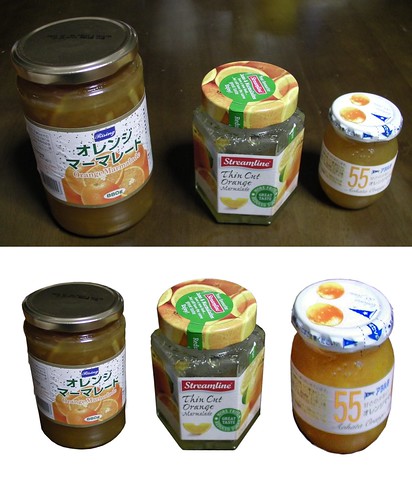Thursday, November 28, 2013
Marmalade in Japan: From a Nacalian Perspective
Displayed above are, from the left, 880g of Egyptian orange marmalade at 198 yen, 400g of Danish orange marmalade at and 398 yen, and 45g of Japanese tangerine marmalade 298 yen.
The Danish is my favourite since it is low in sugar. I feel sorry for the Egyptian children who, so keen to get their hands on Sony Playstations perhaps, must forgo their marmalade in this quantity.
The Japanese marmalade is so expensive because of higher labour and land costs, and because Japanese people trust the quality of products that are made within their shores. But this is getting ridiculous. The price per gram of marmalade is: Egyptian .22 yen, Danish 1 yen, Japanese 6.6 yen. In other words the Japanese marmalade is almost exactly 30 times more expensive than the marmalade imported all the way from Egypt!
In addition to the genuine quality of Japanese marmalade, I sense that other factors are a work.
First of all the size of the Egyptian Marmalade jar may work against it due to the "mottainai" feeling-of-wastefulness that it is likely to invoke in Japanese consumers. Most Japanese marmalade purchasers would think twice about buying such a large jar due to the fact that they would foresee having to throw much or most of it away when, unable to finish it, it starts to rot. That Japanese feel this sense of waste so keenly is due to their greater 'animistic,' Nacalian identification with the visual world.
Secondly, most Japanese, identifying in this way as they do far more with their body image, they are keener to avoid obesity. If on the other hand, you think you are your 'mind' ( self-narrative) then you are more likely, like me, to indulge in a little, or a lot of, marmalade.
Thirdly not only are smaller jars, like smaller Japanese bowls and food servings in general, a major reason for the absence of the pudgy marmalade mouth and beef-burger bottom, they are also made possible again by the Japanese tendency to remain in the living, visual present. The 'imaginary' (in Lacan's terms, for the Japanese sight is a lot more concrete) contains no scale information. A bonsai tree if cultivated and trimmed well, looks the same as a giant oak, if you get up close. A Zen garden looks like an inland sea (Stein, 1990). An a tiny pot of Japanese marmalade can present the same visual content as a massive Danish or Egyptian jar (see the lower row of images). As long as you stay away from symbolic considerations of size and weight ("880 vs 45 grams!)" you can see the world in a pot of Japanese marmalade.
This may explain why the Japanese are fond of moving their rice bowls near to their mouths, or rather their eyes, since up close everything looks bigger. It may also explain part of the sushi-grasp (sushi wo tsumamu) praxis noted by Kitayama (his book, 1995-ish); a sushi in the hand is bigger than a whole fish on the plate.
Finally, there is a degree of exclusive mistrust of things that are not Japanese. Some claim that this is because the Japanese are 'deep and profound' racists xenophobes but some foreign companies do attain trust (such as Louis Vuitton) . It is just that trust be earned through (visual) experience, rather than through (linguistic) promises and the acceptance of the threat of (linguistic) litigation.
Lacan argued that humans pass through the mirror stage, in which they identify with their image, to the symbolic where they identify with language. Nacalianism turns that on its head, in Japan.
Blake. W (1863) "Auguries of Innocence" http://en.wikipedia.org/wiki/Auguries_of_Innocence
Stein, R. A. (1990). The world in miniature: container gardens and dwellings in Far Eastern religious thought. Stanford University Press.
Labels: japan, japanese culture, Nacalian, nihonbunka, 日本文化
This blog represents the opinions of the author, Timothy Takemoto, and not the opinions of his employer.

